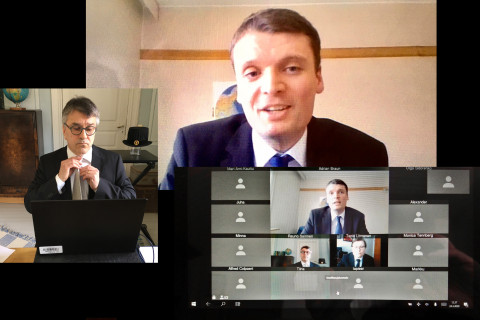The coronavirus pandemic has shaken scientific institutions to their very core, and public examinations of doctoral dissertations are no exception. At the University of Eastern Finland, public examinations were quickly moved online.
When Adrian Braun defended his doctoral dissertation on 24 March, he didn’t have to leave his home. The opponent and the custos attended the event online, as did the audience. Braun’s doctoral dissertation was the first in Finland to be publicly examined online.
His dissertation focusesd on corporate social responsibility in the Barents region. He found that different standards relating to sustainability and social responsibility are useful tools in implementing corporate social responsibility, but there are also challenges. For instance, different standards follow different purposes, such as policy formulation, reporting instructions or auditing, and corporations don’t always have access to or provide information that is compliant with the standards.
“I had an interesting discussion with my opponent in the public examination. I’m happy that I didn’t have to postpone it to next autumn. Of course, it is a shame that I can’t have a proper post-doctoral party, but perhaps I can organise something on a smaller scale after the corona crisis is over,” Braun says.
According to the custos, Professor Rauno Sairinen, the atmosphere of the online public examination was surprisingly similar to that of a traditional one. Everyone was wearing a dark suit, and the custos and the opponent also had their doctoral hats on display. The video angles and the background used in the online room had also been taken into consideration beforehand.
“The custos opened the discussion standing up, after which everyone took their seats. The opening statements went well, and the ensuring discussion was intensive, flowing naturally.”
According to the opponent, Professor Tapio Litmanen, the technical ease of the online public examination was a pleasant surprise.
“The connections worked well, and we didn’t really pay attention to the technology or the platform after we got started. The only thing I noticed were the changing names of audience members as attendees joined in and left the room.”
The audience was given an opportunity for discussion and congratulations after the official part was over.
“My colleagues from the university were able to congratulate me online, and my spouse was also able to thank the custos and the opponent.”
Audience from all over Europe
The online public examination of Braun’s doctoral dissertation was a crowd-puller, attracting an audience of around 70 people. In addition to Finland, attendees from Germany, Sweden, Russia and the UK were present, thanks to the Lifesize Cloud’s virtual room enabling participation from all over the world.
“My relatives and friends from Russian Karelia and Germany were now able to attend the public examination. This would not have been possible, if it had been held physically in Joensuu,” Braun says.
The online public examination was well received.
“Scientists living in other cities thanked the university for opening up this way. In our experience, having a public examination online is something that can be recommended to other doctoral candidates, too. Discussion was of course different but is was close enough to what discussion would have been in a traditional auditorium,” Sairinen says.
Litmanen, too, thinks that the public examination worked well online, thanks to its basic structure being similar to the traditional one.
“In online public examinations, it is wise for the custos to instruct the candidate and the opponent to keep their statements short, so that the interactive nature of the event gets better conveyed to the online audience.
Creating a concept for public examinations held online
According to Adrian Braun, online public examinations could become a permanent alternative to traditional ones especially in situations that require long-distance travel. This is also a way to reduce the carbon footprint of science.
“Consider a situation where the doctoral candidate lives in Australia and he or she would fly a dozen friends and relatives over to Finland just for the sake of the public examination.”
Rauno Sairinen and Tapio Litmanen agree. It would be possible to create a protocol for public examinations held online, and also to develop the visual aspects of the online room.
“As a positive thing, it would take some of the excess ritualism away from the event. However, the festivity and prestige of the event, and academic traditions, could suffer,” Litmanen points out.
“At least we can recommend for public examinations of doctoral dissertations to be live streamed. This would make some of the main culmination points of making science accessible to the public and to interested colleagues from around the world,” Sairinen says.
Despite the good experiences, the traditional public examination, with all its festivities, still has a place in academia.
“When distances are short, a traditional public examination held in an auditorium, followed by coffee and the post-doctoral party, is a tradition worth holding on to,” Braun says.
